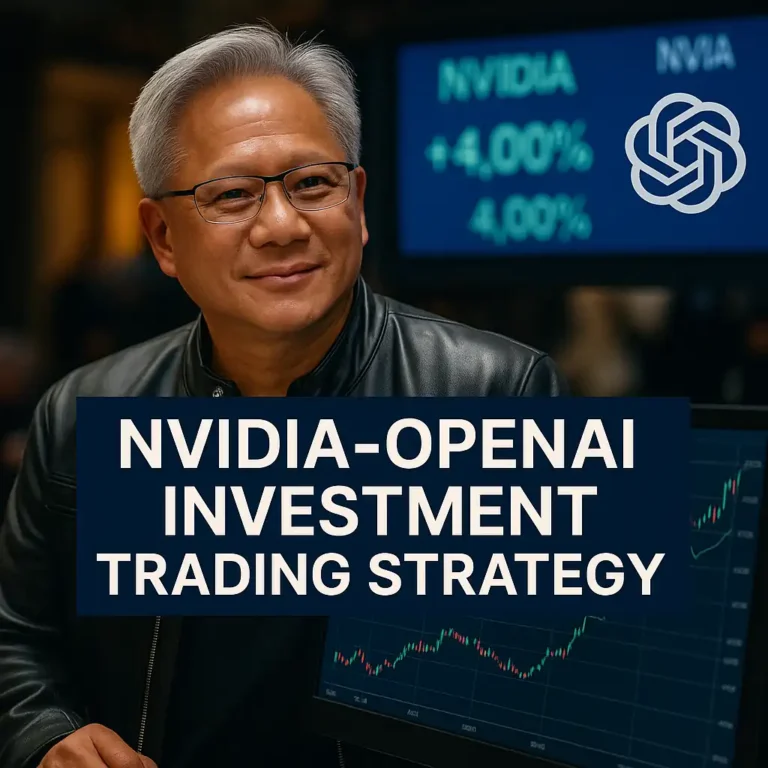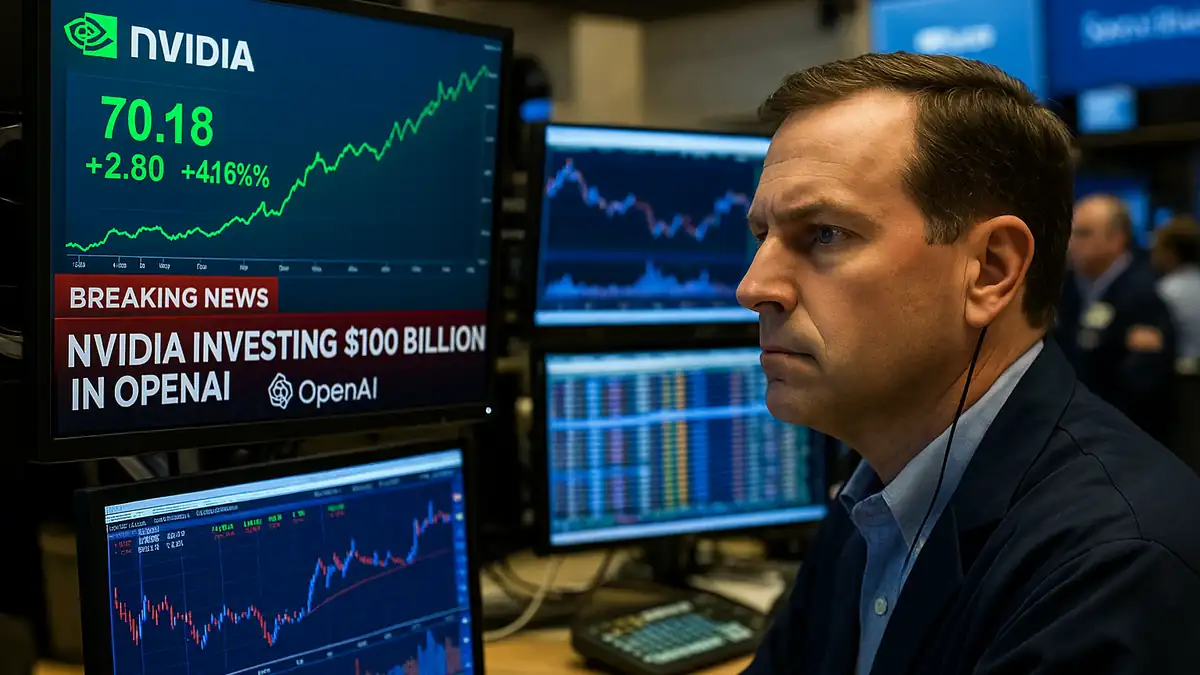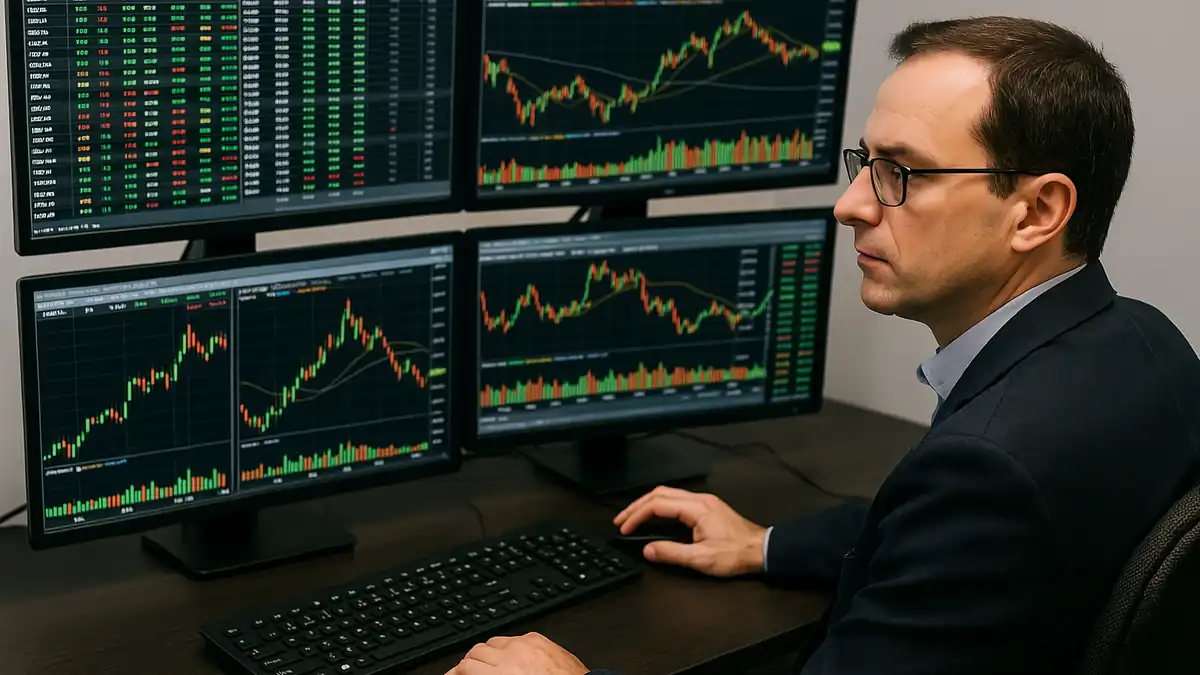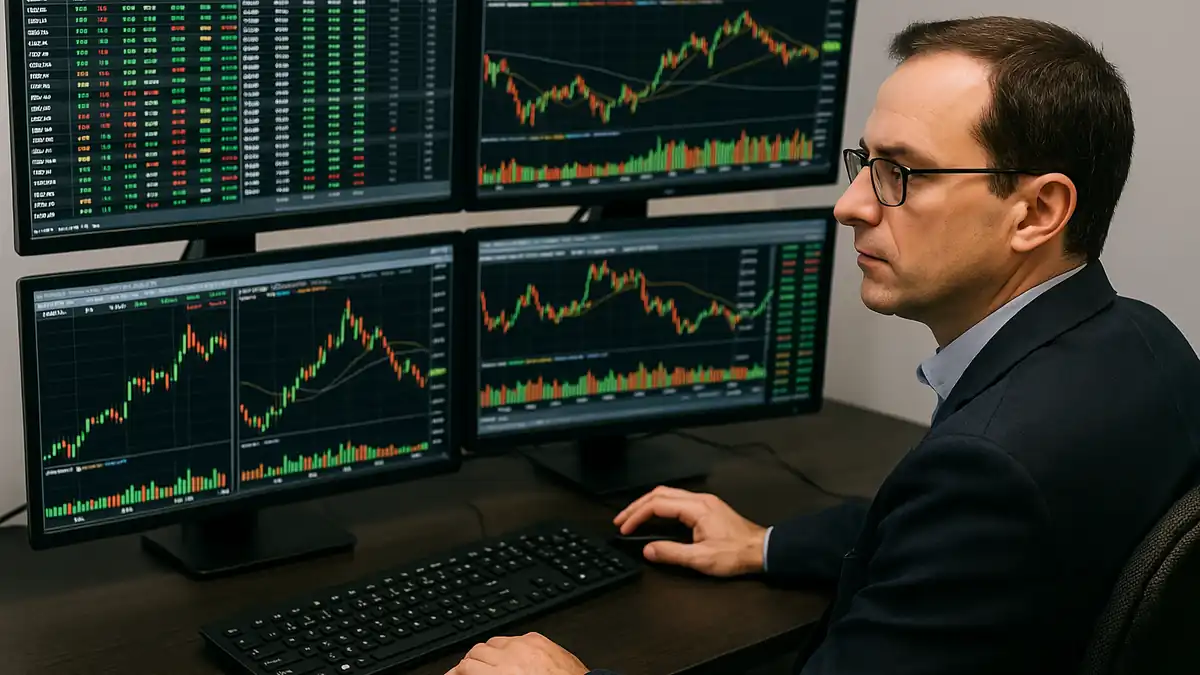
Nvidia’s $100 Billion OpenAI Investment: What It Means for Traders in 2025
Nvidia’s $100 Billion OpenAI Investment: What It Means for Traders in 2025
Nvidia shook Wall Street with news of a $100 billion investment into OpenAI. For traders and long-term investors, this move could reshape the artificial intelligence landscape and spark massive shifts across the stock market. Here’s what you need to know now—and how to prepare your trading strategy.
Key Points
- ⚡ Nvidia announced a $100B investment in OpenAI, solidifying its role as the global AI leader.
- 📈 NVDA stock spiked after the news, with traders eyeing fresh highs in 2025.
- 🤖 The deal could reshape competition with Microsoft, Meta, and Palantir in the AI race.
- 📊 Investors now face both huge opportunities and valuation risks as AI heats up.
Breaking Down Nvidia’s $100B OpenAI Investment
Here’s the practical context behind the headline: how the funding may be structured, what it implies for AI infrastructure demand, and why traders are watching liquidity, guidance, and deployment timelines closely.
Key Details
- 🗓️ Announcement signals a multi-year capital commitment focused on model training, inference capacity, and ecosystem tools.
- 🧠 Expect demand pull-through for accelerators (H100/Blackwell), networking, and software stacks tied to inference at scale.
- 💬 Watch management commentary on capex cadence, supply constraints, and margins; these drive position sizing for traders.
- 🔁 Second-order effects: partner clouds, integrators, and AI platform names that monetize usage rather than only hardware cycles.
Live NVDA Chart
What Traders Should Track Next
- ✓Guidance updates on supply, lead times, and pricing for next-gen accelerators.
- ✓Options skew/IV around earnings and major AI events; consider spreads over naked premium.
- ✓Relative strength vs. SOX/QQQ on pullbacks; leaders should hold higher lows and VWAP.
- ✓Partner names showing usage growth (clouds, platforms, integrators) as confirmation signals.

Next up: why this move centers on model training and inference economics—and how second-order beneficiaries may emerge across platforms and data-center partners.
OpenAI’s Growth & Why Nvidia is Betting Big
Nvidia’s unprecedented $100B commitment reflects confidence in OpenAI’s role as the front-runner in generative AI. From powering ChatGPT’s explosive adoption to driving enterprise deployments, OpenAI represents a massive recurring demand source for advanced compute hardware.
Why This Bet Matters
- 🤖 OpenAI remains the most widely recognized LLM provider with deep integrations across enterprise and consumer apps.
- ⚙️ Nvidia GPUs already underpin OpenAI’s compute stack; the deal reinforces Nvidia as the default AI infrastructure backbone.
- 📈 Analysts estimate model training costs will double yearly, sustaining demand for accelerators and networking gear.
- 🔮 Strategic investment secures Nvidia’s influence in shaping AI standards and monetization pathways for the next decade.
Risk/Reward Snapshot
- ✓Reward: Strengthens Nvidia’s ecosystem lock-in across enterprise AI workloads.
- ✓Reward: Expands optionality into software, frameworks, and long-tail AI monetization.
- ✓Risk: Capital intensity could weigh on free cash flow and investor sentiment.
- ✓Risk: Heavy reliance on one partner introduces concentration risk if AI adoption slows.
OpenAI’s Market Position
OpenAI’s tools, including GPT models and Codex, dominate both public awareness and enterprise pilot programs. The partnership ensures Nvidia captures growth at the application layer, not just at the silicon level.
Why $100B and Why Now?
The timing reflects escalating competitive stakes. With Microsoft embedding OpenAI into its ecosystem, Meta accelerating AI tools, and Google investing heavily in Gemini, Nvidia’s investment ensures it remains indispensable to the sector’s infrastructure and growth.
Next we’ll widen the lens: how this $100B allocation reshapes not just Nvidia and OpenAI, but the entire AI stock universe.
How the $100B Move Ripples Across AI Stocks
Nvidia’s commitment won’t live in a vacuum. Capital, compute, and developer mindshare flow through the ecosystem—lifting some names while pressuring others. Here’s how the shockwave may play out across platforms, semis, and software.
Market Impact: Quick Take
- 🌐 Platforms with deep AI integration (Microsoft, Meta) can see usage tailwinds as model capacity expands.
- 🧩 Infra & tooling names (Palantir, data platforms) benefit if enterprise pilots convert to production scale.
- ⚔️ Competing silicon vendors may face pricing pressure unless they deliver leapfrog performance per watt.
- 📊 Expect sector rotation: leadership should hold higher lows vs. QQQ/SOX during pullbacks.
META
PLTR
AMD

Platforms & Ecosystems
Platforms with distribution and ad stacks can monetize AI features rapidly. Watch DAU/MAU engagement, tooling launches, and developer usage metrics. Sustained adoption should appear as improving operating leverage in quarterly updates.
Semiconductors & Supply Chain
Capacity and node transitions drive the pace of AI buildouts. Competitive responses will center on perf-per-watt, memory bandwidth, and total cost of ownership. Track delivery timelines and customer migrations to gauge share shifts.
Data, Security, and Software
As pilots scale, enterprises need orchestration, observability, and governance. Vendors positioned to productize this stack stand to benefit from recurring revenue and higher gross margins.
With the ecosystem context set, let’s examine the risk side—valuation, policy, and execution— before mapping concrete trading approaches.
Risks Investors Can’t Ignore
Every historic investment headline carries a flipside. For traders sizing up Nvidia’s $100B OpenAI allocation, ignoring the downside can be costly. Here are the primary risks investors need to weigh carefully.
Red Flags to Watch
- 💸 Valuation stretched: NVDA trades at multiples far above the semiconductor sector median.
- 📉 Earnings sensitivity: small misses could trigger outsized drawdowns given expectations.
- ⚖️ Regulatory scrutiny: AI ethics, data privacy, and antitrust investigations remain real headwinds.
- 🌀 Market cycle risk: parallels with dot-com era exuberance highlight potential bubble dynamics.
Valuation Concerns
With a trailing P/E multiple above 70 and forward estimates already embedding aggressive growth, Nvidia’s stock leaves little room for error. A single quarter of slowing demand or margin compression could reset the narrative quickly.
Policy & Regulation
Governments globally are moving toward AI oversight. From export controls on chips to antitrust scrutiny of mega-deals, policy shifts could alter growth trajectories overnight. Investors need to watch both U.S. and EU regulatory calendars.
Execution Risk
A $100B allocation requires flawless execution—supply chains, partner commitments, and developer adoption all need to align. If OpenAI or Nvidia miss delivery milestones, investor confidence could erode fast.

With risk factors on the table, let’s pivot to actionable strategies—how traders can capture upside while keeping downside protected.
Trading Strategies for NVDA After the $100B OpenAI Deal
Nvidia’s OpenAI partnership may be a long-term story, but the stock offers tactical trading opportunities today. Whether you’re a short-term swing trader or a long-term investor, discipline is key. Here’s how to approach NVDA now.
Strategy Snapshot
- 📈 Swing traders: watch for breakout setups above recent highs with strong volume confirmation.
- 🛡️ Options traders: consider vertical call spreads or protective puts to manage premium decay.
- 💹 Long-term investors: dollar-cost averaging can smooth entry points during volatile swings.
- ⚖️ Always align risk per trade to no more than 0.5%–1.0% of equity to avoid outsized drawdowns.
Popular Trading Approaches
| Approach | ✅ Pros | ❌ Cons |
|---|---|---|
| Swing Trading Breakouts | Captures quick momentum; tight stop placement possible | High risk of false breakouts in crowded trades |
| Options Call Spreads | Lower upfront cost; defined risk | Requires timing; capped upside potential |
| Dollar-Cost Averaging | Reduces timing risk; builds long-term exposure | May underperform lump-sum if uptrend continues sharply |

Swing Trading Setups
Look for breakout entries above clearly defined resistance zones, ideally after a short consolidation. Volume spikes should confirm institutional participation. Use ATR or VWAP bands for stop placement and manage risk tightly.
Options Strategies
Given NVDA’s high implied volatility, spreads can help reduce premium costs. Bull call spreads above support zones or protective puts against long stock positions can provide risk-adjusted exposure.
Long-Term Investing
For those holding a multi-year horizon, dollar-cost averaging helps smooth entries across cycles. Use pullbacks to build positions incrementally rather than chasing parabolic rallies.
Beyond tactical positioning, it helps to compare Nvidia’s AI bet with historic tech investments that reshaped entire industries.
Comparing Nvidia’s AI Bet to Past Tech Booms
The scale of Nvidia’s $100B OpenAI investment invites comparisons to earlier turning points in technology history. Looking back at Microsoft’s cloud push, Amazon’s AWS gamble, and Google’s YouTube acquisition reveals both parallels and lessons for today’s traders.
Historic Parallels
- ☁️ Microsoft’s multibillion-dollar Azure push defined the cloud era—similar long-horizon vision.
- 📦 Amazon’s AWS expansion turned a risky infrastructure play into the firm’s most profitable unit.
- ▶️ Google’s YouTube acquisition seemed bold in 2006, but became the cornerstone of digital video.
- 📊 Lesson: outsized bets can unlock dominance, but execution risk is always the deciding factor.
Microsoft and the Cloud Bet
Microsoft’s Azure initiative required enormous capital and years of execution before reaching profitability. Traders initially doubted the model, yet today Azure anchors recurring revenue. Nvidia’s AI bet has similar long-dated payoffs that may not be visible in quarterly reports.
Amazon Web Services
AWS began as an internal tool and evolved into a $90B+ revenue powerhouse. Early skepticism gave way to dominance, rewarding patient investors. Nvidia’s GPUs could play the same foundational role for AI infrastructure that AWS did for the cloud.
Google’s YouTube Purchase
At the time, paying $1.6B for YouTube looked extravagant. But YouTube ultimately transformed advertising and engagement. Nvidia’s OpenAI deal carries similar transformational potential for enterprise AI adoption.
With historic parallels in mind, let’s consider what analysts are saying about Nvidia’s bold bet—and how the Street is framing opportunities and risks.
What Analysts Are Saying About Nvidia’s $100B OpenAI Bet
Wall Street and independent research desks have been quick to weigh in on Nvidia’s unprecedented commitment. Their perspectives provide valuable context for traders trying to separate hype from execution risk.
Analyst Highlights
- 📊 Yahoo Finance: Analysts frame the deal as “a generational opportunity” but warn valuations leave no room for error.
- 📰 Reuters: Highlights how the deal cements Nvidia as the AI hardware backbone while raising questions about capital intensity.
- 💡 Bloomberg: Notes investor enthusiasm but reminds traders of parallels to past tech bubbles and the need for careful sizing.
- 📈 Morningstar: Suggests that even if adoption accelerates, near-term volatility should be expected as sentiment drives multiples.
NVDA Market Snapshot
Street Consensus vs. Caution
The consensus leans bullish, emphasizing Nvidia’s structural advantage in AI infrastructure. However, the repeated caution across reports is clear: the magnitude of the deal leaves no margin for operational missteps.
Independent Voices
Outside traditional banks, independent research firms point to risk factors like supply chain bottlenecks, reliance on hyperscalers, and macroeconomic headwinds. These perspectives add nuance beyond mainstream enthusiasm.
After digesting analyst views, traders must balance optimism with discipline. Next, let’s wrap up with the key conclusions and actionable FAQs.
Conclusion: Nvidia’s Defining AI Gamble
Nvidia’s $100B OpenAI investment is more than a headline—it’s a watershed moment for the AI economy. For traders, the move presents both historic opportunities and serious risks. The playbook is simple: respect the trend, control position sizing, and stay disciplined in risk management. Whether you’re a short-term swing trader or a long-term investor, this deal underscores why Nvidia is the center of gravity in AI markets.
Learn how to exit positions strategically before euphoria fades.
Timeless principles for managing risk and capturing momentum.
High-probability trading patterns you can apply to NVDA and beyond.
Frequently Asked Questions
Why did Nvidia invest $100B in OpenAI?
Nvidia aims to secure its role as the global AI infrastructure leader while capturing value from OpenAI’s explosive growth in generative AI applications.
How will this affect Nvidia stock price?
In the short term, sentiment-driven rallies are possible. Long term, execution and AI adoption rates will determine whether multiples are justified.
Is it too late to buy Nvidia stock?
Not necessarily—opportunities exist on pullbacks. Traders should use disciplined entries and long-term investors may consider dollar-cost averaging.
What are the risks of investing in AI stocks?
Key risks include high valuations, regulation, execution challenges, and potential overhype resembling past tech bubbles.
Which other stocks could benefit from Nvidia’s move?
Beneficiaries may include Microsoft, Meta, Palantir, and semiconductor peers like AMD and TSMC as AI adoption accelerates.

Evan O’Hara
Founder of TradeStockAlerts.com, Evan shares insights on day trading, swing trading, and AI-driven market trends. He has over a decade of experience in financial markets and a passion for helping traders grow with disciplined strategies.